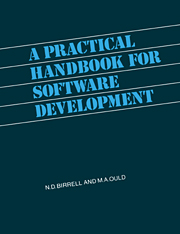
-
Select format
-
- Publisher:
- Cambridge University Press
- Publication date:
- 11 January 2010
- 16 May 1985
- ISBN:
- 9780511624223
- 9780521347921
- Dimensions:
- Weight & Pages:
- Dimensions:
- (246 x 189 mm)
- Weight & Pages:
- 0.49kg, 272 Pages
You may already have access via personal or institutional login
Book description
The designer of a software system, like the architect of a building, needs to be aware of the construction techniques available and to choose the ones that are the most appropriate. This book provides the implementer of software systems with a guide to 25 different techniques for the complete development processes, from system definition through design and into production. The techniques are described against a common background of the traditional development path, its activities and deliverable items. In addition the concepts of metrics and indicators are introduced as tools for both technical and managerial monitoring and control of progress and quality. The book is intended to widen the mental toolkit of system developers and their managers, and will also introduce students of computer science to the practical side of software development. With its wide-ranging treatment of the techniques available and the practical guidance it offers, it will prove an important and valuable work.
Reviews
‘This book is remarkable for its breadth of scope and perspective.’
Source: ACM Software Engineering Notes
‘ … it successfully brings together a host of material, taken from many different sources and covering all stages of software development. The organization of the book is excellent …’
Source: The Times Higher Education Supplement
Contents
Metrics
Altmetric attention score
Full text views
Full text views help Loading metrics...
Loading metrics...
* Views captured on Cambridge Core between #date#. This data will be updated every 24 hours.
Usage data cannot currently be displayed.
Accessibility standard: Unknown
Why this information is here
This section outlines the accessibility features of this content - including support for screen readers, full keyboard navigation and high-contrast display options. This may not be relevant for you.
Accessibility Information
Accessibility compliance for the PDF of this book is currently unknown and may be updated in the future.


